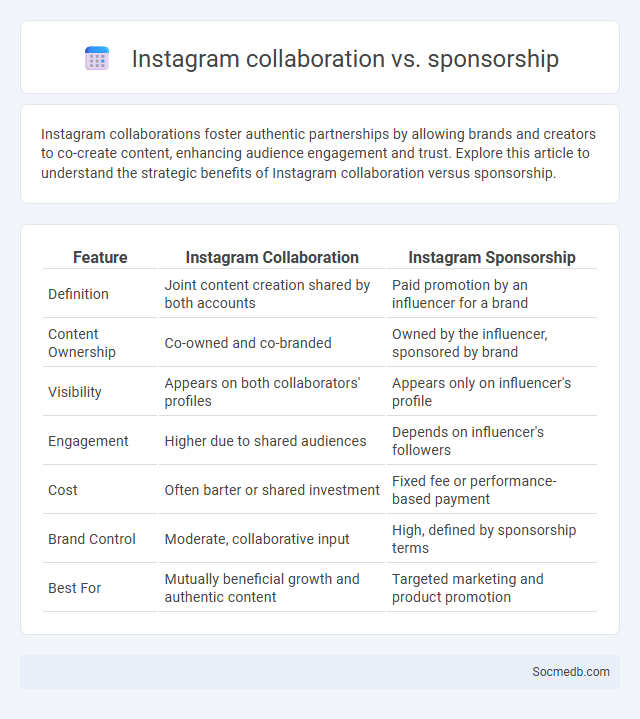
Photo illustration: Instagram collaboration vs sponsorship
Instagram collaborations foster authentic partnerships by allowing brands and creators to co-create content, enhancing audience engagement and trust. Explore this article to understand the strategic benefits of Instagram collaboration versus sponsorship.
Table of Comparison
| Feature | Instagram Collaboration | Instagram Sponsorship |
|---|---|---|
| Definition | Joint content creation shared by both accounts | Paid promotion by an influencer for a brand |
| Content Ownership | Co-owned and co-branded | Owned by the influencer, sponsored by brand |
| Visibility | Appears on both collaborators' profiles | Appears only on influencer's profile |
| Engagement | Higher due to shared audiences | Depends on influencer's followers |
| Cost | Often barter or shared investment | Fixed fee or performance-based payment |
| Brand Control | Moderate, collaborative input | High, defined by sponsorship terms |
| Best For | Mutually beneficial growth and authentic content | Targeted marketing and product promotion |
Understanding Instagram Collaborations
Instagram collaborations enhance brand visibility by merging audiences and fostering authentic engagement. Leveraging influencer partnerships on Instagram helps target niche markets, driving higher conversion rates through personalized content. Effective collaboration strategies include clear goal alignment, transparent communication, and data-driven performance analysis.
Defining Instagram Sponsorships
Instagram sponsorships involve brands partnering with influencers to promote products or services through authentic, engaging content on the platform. Your collaboration can leverage the influencer's audience reach and trust to increase brand visibility and drive targeted conversions. Understanding the key elements like sponsored posts, disclosure requirements, and performance metrics is crucial for maximizing the impact of Instagram sponsorship campaigns.
What is a Brand Partnership on Instagram?
A brand partnership on Instagram involves a collaboration between a business and a content creator to promote products or services through sponsored posts or stories. These partnerships leverage the influencer's audience to increase brand visibility, engagement, and sales, using features like branded content tags for transparency. Effective brand partnerships drive authentic connections, enhance trust, and boost marketing ROI on the platform.
Key Differences: Collaboration vs Sponsorship vs Partnership
Collaboration on social media involves mutual content creation where both parties actively contribute ideas and share audiences, fostering organic engagement. Sponsorship typically features a brand paying an influencer or content creator to promote products or services, emphasizing brand messaging and targeted reach. Partnerships are long-term associations combining resources, goals, and co-branded campaigns aimed at sustained growth and deeper audience connection.
Pros and Cons of Instagram Collaborations
Instagram collaborations enhance brand visibility and audience engagement by merging follower bases and showcasing diverse content authentically. They drive targeted marketing efforts, increasing conversion rates and fostering community trust through influencer credibility. However, collaborations can risk brand misalignment, create dependency on partner reputation, and require careful contract management to avoid disputes or inconsistent messaging.
Benefits and Challenges of Sponsorships
Sponsorships on social media boost brand visibility and engagement by leveraging influencers' reach and credibility across platforms like Instagram and TikTok. Challenges include maintaining authenticity to avoid audience skepticism and navigating advertising policies on platforms such as Facebook and YouTube. Effective sponsorships require careful alignment between brand values and influencer content to maximize ROI and consumer trust.
Brand Partnerships: Long-Term Value and Impact
Brand partnerships on social media generate long-term value by fostering authentic connections with target audiences and increasing brand loyalty through consistent engagement. Strategic collaborations leverage influencer reach and user-generated content to amplify brand awareness, driving sustained growth in brand equity. Data-driven insights from social media analytics optimize partnership outcomes, enhancing campaign effectiveness and maximizing return on investment over time.
Choosing the Right Approach for Influencers
Selecting the right approach for influencers involves understanding your target audience and aligning with influencers whose values and style resonate authentically. Your campaign's success depends on clear communication, setting measurable goals, and choosing platforms where engagement is highest. By tailoring your strategy to fit both the influencer's unique voice and your brand's objectives, you can maximize reach and foster genuine connections.
Best Practices for Brands on Instagram
Brands on Instagram should prioritize creating visually compelling, authentic content that resonates with their target audience to boost engagement and brand loyalty. Consistent use of relevant hashtags, Stories, Reels, and interactive features like polls or Q&A enhances discoverability and fosters community interaction. Leveraging Instagram Insights allows brands to analyze follower demographics and content performance, enabling data-driven strategies for optimized posting times and content types.
How to Measure Success: Collaboration vs Sponsorship vs Partnership
Measuring success on social media requires analyzing engagement metrics, reach, and conversion rates tailored to your collaboration, sponsorship, or partnership goals. Collaborations often excel in fostering authentic audience interactions, sponsorships typically boost brand visibility through paid placements, and partnerships drive long-term engagement by combining resources and shared objectives. Your success metrics should align with these distinctions to effectively evaluate the impact and ROI of each approach.
 socmedb.com
socmedb.com